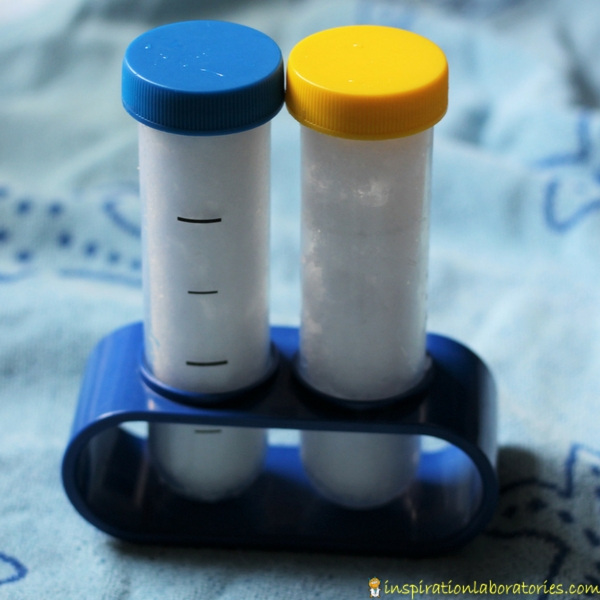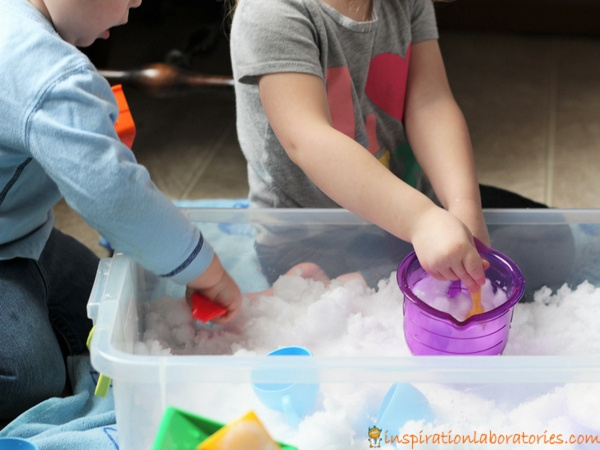Snow Science Explorations for Kids
Are you ready for some snowy play ideas? Try our snow science explorations inspired by The Snowy Day by Ezra Jack Keats. Grab some snow (or make your own) and try out these science ideas. Be sure to check out all of the snow themed activities at the end of the post. I get commissions for purchases made through the affiliate links in this post.

The Snowy Day by Ezra Jack Keats
The Snowy Day is an award winning book about a little boy named Peter and his adventures on a snowy day. His iconic red snowsuit jump out on the snow filled pages. Follow along as Peter makes tracks in the snow, watches a snow ball fight, climbs a snowy hill, builds a snowman, and more. Watch the animated read aloud version of The Snowy Day on Ezra Jack Keats website.
Snow Science Explorations for Kids
If you have enough snow, bring a bucket or two inside for experimenting. If you don’t have any, you can make make your own snow by crushing some ice in a blender. That’s what I did for today’s snow science.
What Happens to Snow Inside?
Our first snow science exploration comes straight from the book. Peter places a snowball in his pocket to save it for another day. When he returns after his bath, the snow is gone. I asked my 3 year old what happened to the snow. She said she didn’t know. I asked her if she wanted to do an experiment to find out. She was game.

We took some of our homemade snow and filled up two test tubes (given to us by Learning Resources). We let them sit and waited to see what would happen. While Lily was playing with the snow she dropped some of it next to the vent. The snow melted. This led to a discussion about why the snow melted. We talked about freezing temperatures and water, ice, and snow. I asked her to predict what will happen to the snow in the test tube and she said it would melt.

How Much Does Snow Weigh?
Our second snow exploration uses a balance to look at how much snow weighs. The kids placed two little cups of snow on the balance. (Our balance was given to us by Learning Resources as was some of the other measuring cups and bowls.)

Their weights were not equal. They placed just the cups on the balance and their weights were equal. We talked about how the amounts of snow in the cup were different. Maybe one of the cups had packed snow and the other cup had a big space.

Which weighs more – a “cup” of snow or a “cup” of water? The cup of water weighs more. This investigation allowed us to talk about how much space (or volume) the snow took up and how much space the water takes up. This is because water expands when it freezes. And snow contains air and ice.

We reinforced this investigation with our melting snow test tubes. The test tubes were filled with snow. After they melted the test tubes were not full of water.
Lily and Elon also compared different containers filled with snow.

They had fun transferring snow from one container to another playing in the snow.

Looking for More Snow Experiments?
- Add cars to your snow. Build a ramp and crash cars into the snow.
- Try another simple snow science experiment. How long will it take the snow to melt in different locations?
- What happens when you add water to snow? Find out in this snow and water science experiment.
- Make fizzy snow.
- Check out even more ice and snow science experiments.
More Activities from the Virtual Book Club for Kids
See more snow themed activities inspired by The Snowy Day:
Snow Themed Alphabet Sensory Bin – The Educators’ Spin On It
Snowball Name Fight – Rainy Day Mum
Snowball Number Recognition Game – School Time Snippets
Bring In the Snow! – Mama Smiles
Snowstorm in a Bag – JDaniel4’s Mom
Snowy Day Sticky Table for Toddlers – Toddler Approved
Easy Winter Toddler Art – Messy Little Monster
Winter Science: Fizzing Snowmen – Teach Beside Me
Painting in the Snow with 3 Ingredient Snow Paint – Views From a Step Stool
Subscribe to the Inspiration Laboratories newsletter. Each issue has exclusive hands-on science explorations for children, a recap of our latest activities, and special resources selected just for you!


Leave a Reply